
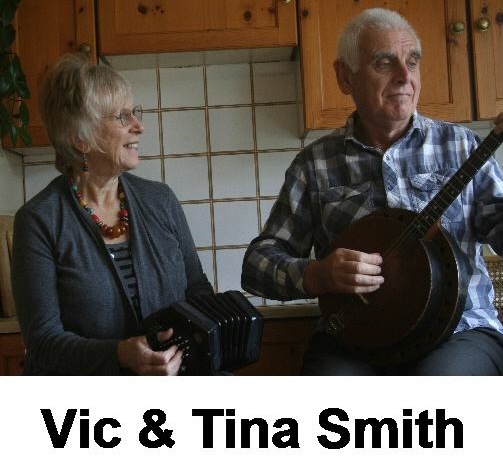

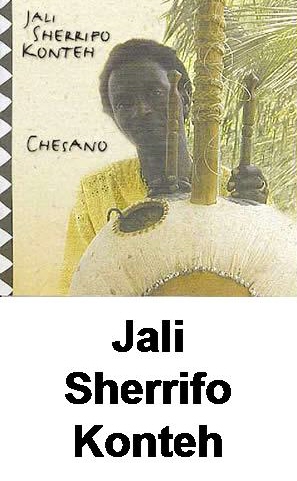
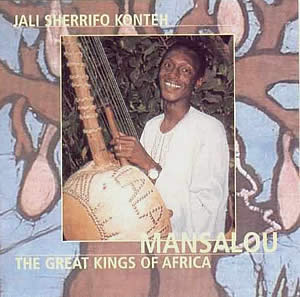
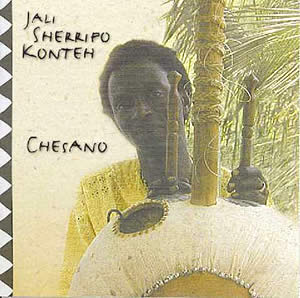
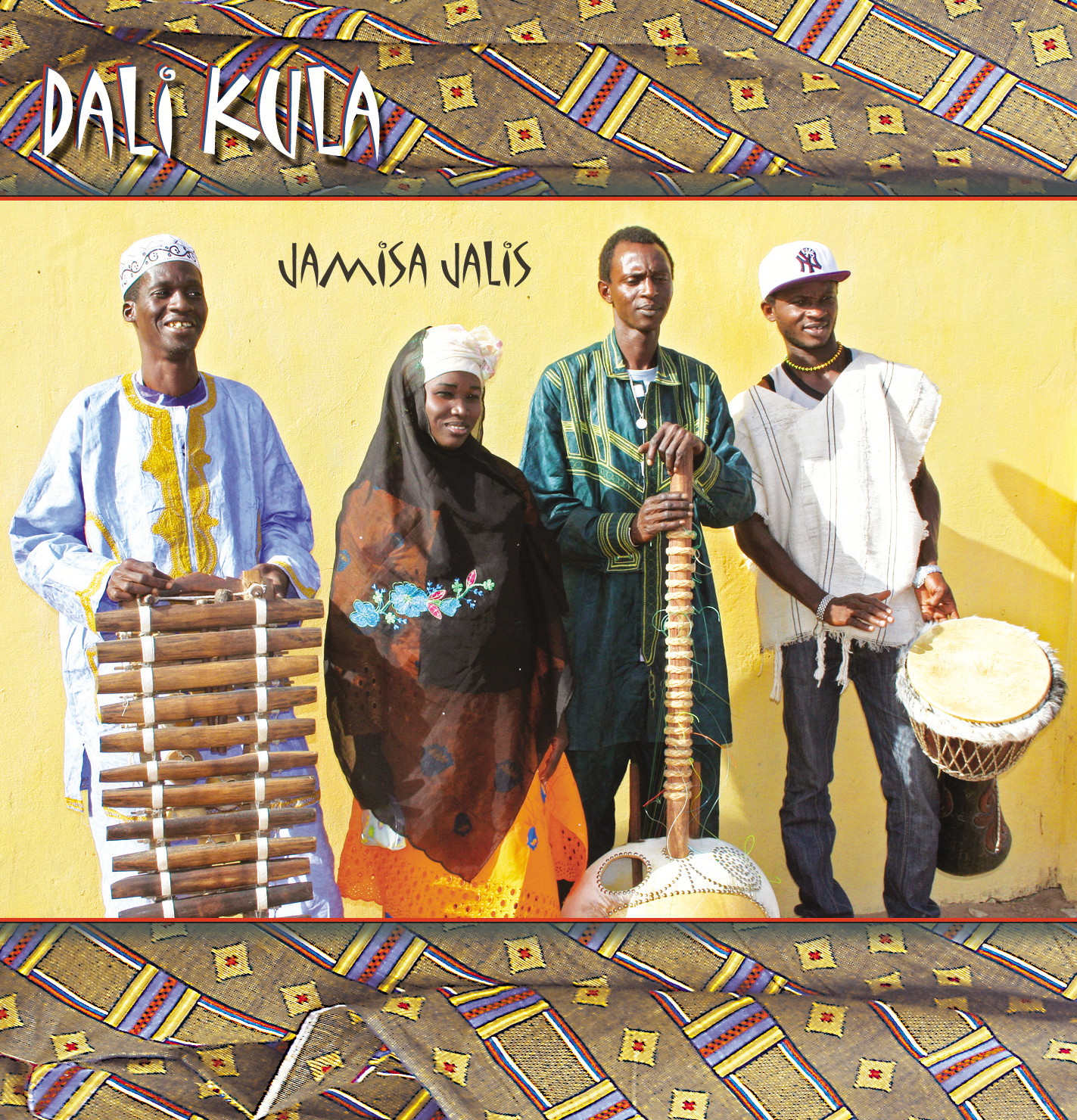
JALI SHERRIFO CONTEH
Click to go to: -
BUY ALBUM(S)
Please email us for details of a considerable discount if you buy all three albums or if you buy multiple copies of the same album or for any other enquiries.
Jamisa Jalis: Jali Sherrifo Konteh with Suntou Kouyate, Ismaela Marong & Makoy Jobarteh

DALIKULA
"The Way We Used To Live"
Compound Sounds CS 03 (2013)
Jali Sherrifo Konteh now lives in his own compound that he has built and developed in the Jamisa area in the west of Brikama. Also living in his compound are the family of his lifelong friend, the balafon player, Suntou Kouyate; that's his wife Makoy Jobarteh and their two children. Sherrifo's younger half-brother, Ismaela Marong is a frequent visitor to their compound. Three of the four musicians on this CD all earn their living from their music, by performing and making instruments, but they do not perform together as a regular band. Instead this is the music that they play and sing at home, often just for their own amusement, but also for friends and neighbours.
You can also, if you prefer, order by sending a cheque (£ sterling only, please) to the address below.
Studio album by Jali Sherrifo Konteh

CHESANO
Jali Sherrifo Konteh
Compound Sounds CS 02 (2005)
This album was released to co-incide with the start of Sherrifo's 2005 British tour. It was sold at all his appearances, but is also available through this website for £12, which includes postage & packing within the UK for a single item. (If you live outside the UK postage will be higher, and if you want to order more than one item the total postage will be reduced, so in these cases, instead of ordering on this web site, please email us for a specific price.)
You can also, if you prefer, order by sending a cheque (£ sterling only, please) to the address below.
 MANSALOU
MANSALOU
Jali Sherrifo Konteh
Compound Sounds CS 01 (2001)
Price £12, which includes postage & packing within the UK for a single item. (If you live outside the UK postage will be higher, and if you want to order more than one item the total postage will be reduced, so in these cases, instead of ordering on this web site, please email us for a specific price.)
These are the first recordings of a wonderful young singer and musician who is clearly destined for a great future as a leading exponent of West African traditional music. The son of Alhaji Bai Konte and the brother of Dembo Konte, Sherrifo learned from both and has become an outstanding musician in his own right.
The kora has been described as Africa's greatest musical instrument. The earliest references to it date back to the eighteenth century though it may be older. It is unique to the Manding people of West Africa. In recent years the instrument has become more widely known through the playing of some remarkable virtuosos, nearly all of whom come from the "jali" or "griot" families. These are the hereditary orators, musicians and singers who have played such a vital role in their societies over the centuries, recording orally the history and genealogy of their people, noting customs, laws, archives and composing songs honouring famous figures. They were able to promote a realisation and awareness of a rich historical heritage that can be traced back to the great Manding king Sunjata Keita who ruled over the huge Empire of Mali in the 13th century.
Sherrifo comes from one the most famous of the jali families from a town that is the home of many griot families. All his life he has been steeped in this rich tradition. He has a highly developed and inventive technique playing the kora which scintillates and sparkles and compliments his commanding singing. Some of his songs reflect the long tradition that he is a continuing part of; others comment on contemporary social mores. He performs them all with a passion and commitment that make them truly engaging listening.
Jali Sherrifo Konteh
Compound Sounds CS 01 (2001)
All CDs cost £12 including P&P within the UK from:-
Vic & Tina Smith,
26 Ferrers Road,
Lewes,
East Sussex,
BN7 1 PZ
England
Tel:- 01273 478124
Email
Cheques payable to Vic & Tina Smith .

SHERRIFO INTRODUCES HIMSELF
Western people have written many articles about West African culture but I decided it would be a good idea to write about the culture from my own point of view, as a jali myself.
This article will explain the culture, tradition and structure of Mandingo griots in The Gambia. It will tell where they came from, the reason behind their migration, their first settlement in The Gambia and their mode of settlement.
The historical background also looks at the duties of Mandingo griots in the context of the Senegambia society. Griots emerged as a separate group that had its own internal structure. This self-organisation of the griots shows the inter-relationship between them and their organisational structures.
A DEFINITION OF GRIOTS
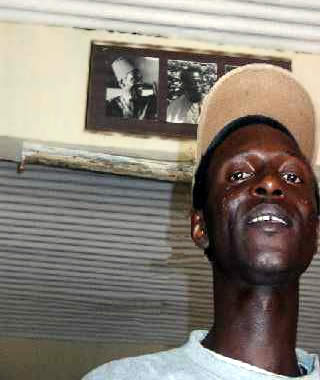
Griots (or Jalis in Mandinka) are oral historians who can trace their origins and status from the first griot,
Nyankuma Duga Kuyateh. They are called nyamakala, or in Mandinka nyamalo, and are the people
belonging to the griot sect in the Mandinka community. They are born into certain professions and a son would
be expected to follow in his father’s footsteps. Me, myself, I learnt to play the kora first of all from
my Daddy and he learnt from his Dad. It is a hereditary role. Jalis are equipped with entertaining instruments
for performing and anyone who cannot trace their lineage from Nyankuma Duga Kuyateh and does not fulfil their
griot role by performing is not a true griot. Essentially griots are libraries to the Mandingo tribe.
This picture of me was taken in the compound that belonged to his father, Alhaji Bai Konte. We are looking over
my shoulder at photographs of my father,(left) and my late older half-brother, Dembo. The photo was taken in
March 2005.
HISTORICAL BACKGROUND AND ORIGINS OF THE MANDINGO GRIOTS
Certainly everyone has a root and tracing this root is extremely important. It is generally believed that the Mandingos came from the ancient great Mali Empire from a town called Manding. The leaders of the Empire were from the Manding region that engulfed the whole area of the east (Teliboh). Nearly all the rulers of the Mali Empire had the desire to expand the boundaries of the Empire to bring a vast area under their hegemony. This was particularly manifest during the era of Sundiata Keita, for he had the military might to execute such a function. Among his generals was Tiramakalig Traore. Tiramakalig expanded the boundaries of the great Mali Empire up to the Senegambia region. As he was progressing, he had griots with him to praise him and his soldiers to inspire them to fight and win battles.
The Mali Empire extended up to Sine and Salom in the bolongs of The Gambia in the Upper River Division and that was where the Mandingo griots had their first settlement. Tiramakalig himself died in the Wuli district after his final settlement in the region. Even today the people living in these areas speak exactly the same as the original Mandingos of Manding. The people who came from the Mali Empire resettled and intermarried in the region. They stayed there for quite a long time before moving to the coast (Kombos).
Nowadays Mandingos and their griots are seen in every part of The Gambia, but particularly in Brikama, Mandinba, Lamin and Banjulinding in the Western Division. There were several reasons for this exodus to the western areas. The griots living in the Wuli Tumona, Fullady and Kantora areas came to know about the Western Division as a favourable area to live in and that motivated many of them to migrate there. They were also attracted by the favourable climatic conditions of the Western Division. The Upper River Division is very warm compared to Western Division, which is close to the coast and much cooler.
There was also a chance for rich people to be their batufaas (people who they depended on completely to support them, and who did not just book them for festive occasions). Batufaas (patrons) to the griots were not unusual. Griots depended on these batufaas for many reasons. They had to follow these important people to obtain benefits from them. As the saying goes, "A griot without a butafaa is meaningless". It did not mean that anyone who gave something to a griot was a butafaa. The butafaa were very special to griots and often interfered even with the structural organisation of the griots. Sometimes griots even lived with them.
Some griots moved to the Western Division to look for markets for the products they had made, such as a kora or a balafon. Nowadays some griots earn their living making and selling musical instruments. Sales are very limited in the interior as there are not many clients there but buyers are more numerous around the coast. People come from Senegal, Mali and Guinea Conakry to buy items to take back to their own countries. Also during the tourist season, many tourists become interested in these artistic Gambia makings and they buy them in bulk from the griots. This lucrative profession around the coast was another reason the griots were attracted to settle in Western Division.
I make my own koras. It is a difficult job. First of all it takes two weeks' work, but not in the rainy season. In the dry season you can make koras for yourself because of the sun. It needs a large calabash (a type of gourd), and the volume of the kora will depend on the size of the calabash. You also need mahogany wood and the skin of a cow. Three different thickness of nylon fishing line are used for the strings but before our great-grandfathers used to use cow skins, cut into thin strips and twisted. The sound was different and quieter. Plaited loops of cow skin are used to attach the strings to the mahogany pole and they are pushed up and down the pole to tune the strings. Drawing pins are used to attach the skin to the calabash. All the koras I make can be played professionally. Many people make koras now, mainly to sell to tourists and they will have a smaller number of strings, but if you want a 21-string kora you can play professionally you have to go to a griot family. My father was recognised as the best kora maker in The Gambia.
THE SURNAMES OF THE MANDINGO GRIOTS
The common Mandinka griot surnames are Kuyateh, Konteh, Kanuteh, Jabarteh, Suso and Saho. There is a relationship between the different surnames in the griot society. Kuyatehs are described as superior to the others. People ask how it is possible for Kuyateh to demand alms (money) from them and not vice versa? This is essentially because the Kuyateh are termed the first griots. Based on that they enjoy special privileges that others may not have but this does not necessarily mean that they are superior. The griot gave them the title Mansa Jali to honour their status as the first griots in the history of the Mandingos. It is extremely difficult to have superiority in the noble society of Mandingo griots.
ROLE OF MANDINGO GRIOTS
This is a very important area when dealing with the history of Mandingo griots. Griots right back from their very origins (Manding) have been performing duties that are important and prominent in our society. These duties were being and are still being performed in naming ceremonies, weddings, and political and cultural meetings. They sometimes are also interpreters and perform other concomitant functions.
Griots entertain people during weddings and naming ceremonies. At these ceremonies they are seen with their instrument such as kora, balafon and kontingo, playing and singing to amuse their audience. It is a convention in the Mandinka society that, prior to weddings and naming ceremonies, the griots are assigned to inform the general public about the event. This is essential to make everyone prepared for it. While the griots are playing and praising their bafufas at occasions the bafufas give out money, clothes, jewellery, silver, gold etc. to them as a way of pleasing them.
Not only at these occasions but also at political meetings, griots are called upon with their instruments to perform before the start of the programmes. This is clearly manifested even nowadays when the President is going on a “meet the people“ tour or to a political meeting, then griots are called upon to perform. Village or town meetings are also often preceded by a display of griots.
As praise singers they help kings to win battles since they have the word power to make people do things beyond their abilities. However brave a leader might be, he can only be known to people through griots. It is the griiots who reveal who someone is, what he did, what he is capable of doing and what are his plans for the future. Griots also settle disputes amongst people who are living together as all human beings are liable to have problems.
Mandingo griots are known to entertain people around them, and the instruments they possess assist them a lot in executing this function. Among these instruments are the kora, the balafon, the kontingo, the tama, the mdolh and neos (an iron nail used to tap a rhythm on the calabash of the kora, and the only instrument used by female jalis). They use these instruments collectively to provide an entertaining ground in which amused audiences give money as a way of thanking them.
Among the instruments mentioned, the kora, balafon and kontingo can be used individually to entertain people but the rest have to be joined with the key instruments of kora , balafon and kontingo when playing.
TUNES AND SONGS OF THE GRIOTS
Tunes are still being composed by some jalibas in our present generation out of their imagination, but initially griots composed tunes to relate to an ongoing situation, either to praise an event or a particular group of people. People were able to learn of the existence of certain activities because griots were talking and singing about them, and these tunes are still being played today. These traditional tunes include Tiramang; Chedoh; Lambang and Simbong.
I mostly write my songs in the Mandinka language. I write about how things are changing between the generations; about my friends who have been good people and about things that have affected my life. I wrote about a good friend who died very young. I had been away playing and when I returned I found he had died. I took my kora to his compound and played the song for his family.
STRUCTURE OF THE MANDINGO GRIOTS
It is very difficult for any society to continue its existence without having able leadership to keep the society functioning. In the griot society there were able elders who were so energetic in mind and physical abilities they were able to keep us going. These leaders were executing these duties since the era of Sumangru Kanteh (before Sundiata Keita) when Nyankumang Duga Kuyateh, the first griot, was doing that and it was passed to succeeding generations up to now. Among such leaders in The Gambia was my own father, Jali Alhagie Bai Konteh (Brikama); Amadou Bansang Jobarteh (Kembujuh); Jali Bakary Saho (Bannie Kantora) and Jali Nyanma Suso (Bakau) a Gambian griot professional based and laid to rest in Mali.
The situation today is that some members of the griot family tend to neglect this noble culture of theirs. Some are seen to be concentrating on western education, which is a great mistake. This can easily lead to the fading away or the disappearance of the griot culture in the future generations to come. Some non-griots also like to train and become experts in the various instruments used by the griots but still that is on a decreasing rate. I like to remain traditional and play with traditional scales and tuning and preserve the songs that my forefathers have sung and to compose new material based on traditional structures. But if at all I have a daughter I will teach her to play the kora, as at present no Gambian women play a musical instrument. Some things I would change.
Jali Sheriffo Conteh

MAKING A KORA
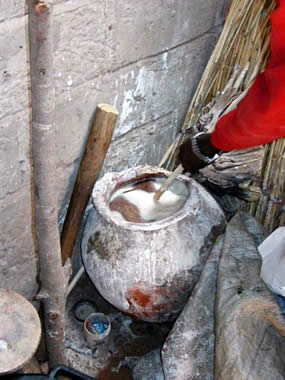 The sounding body of the kora is made from a half a calabash gourd covered with cowhide. The cowhide is soaked in a bath of chemicals for three or four days. This makes it much easier to remove the hairs and makes the normally tough leather very soft and pliable and it also bleaches the skin white.
The sounding body of the kora is made from a half a calabash gourd covered with cowhide. The cowhide is soaked in a bath of chemicals for three or four days. This makes it much easier to remove the hairs and makes the normally tough leather very soft and pliable and it also bleaches the skin white.
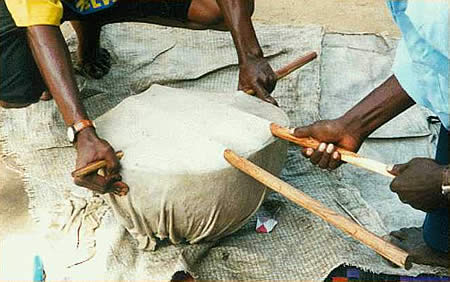 The wet skin is the wrapped over the open half of the calabash and ties firmly at the back. Whilst the skin is still soft and pliant, the two mahogany hand poles and the transverse pole are fitted. This in then let in the sun to dry for a few days and whilst it is drying the skin shrinks when thus fitting very tightly over the calabash. The need for this drying process means that koras can only be made during the dry season from mid-November to mid-June.
The wet skin is the wrapped over the open half of the calabash and ties firmly at the back. Whilst the skin is still soft and pliant, the two mahogany hand poles and the transverse pole are fitted. This in then let in the sun to dry for a few days and whilst it is drying the skin shrinks when thus fitting very tightly over the calabash. The need for this drying process means that koras can only be made during the dry season from mid-November to mid-June.
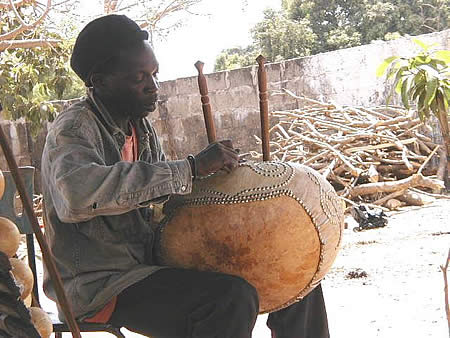 When the skin is dried, it is cut around the calabash and then attached to the edge with brass-headed pins. Some koras have the most beautiful and intricate designs created by these pins. Sherrifo favours using as few pins as are necessary for two reasons. He claims that by using too many pins the maker will deaden both the tone and the volume of a kora. In addition, he does a lot of his playing whilst standing or walking around, so he wants his kora to be as light as possible. A round sound hole is cut in the closed half of the calabash and this is also edged with the pins. A round wooden pole made of mahogany is to be used for the neck. For each string a wet strip of cowhide is plaited round this pole.
When the skin is dried, it is cut around the calabash and then attached to the edge with brass-headed pins. Some koras have the most beautiful and intricate designs created by these pins. Sherrifo favours using as few pins as are necessary for two reasons. He claims that by using too many pins the maker will deaden both the tone and the volume of a kora. In addition, he does a lot of his playing whilst standing or walking around, so he wants his kora to be as light as possible. A round sound hole is cut in the closed half of the calabash and this is also edged with the pins. A round wooden pole made of mahogany is to be used for the neck. For each string a wet strip of cowhide is plaited round this pole.
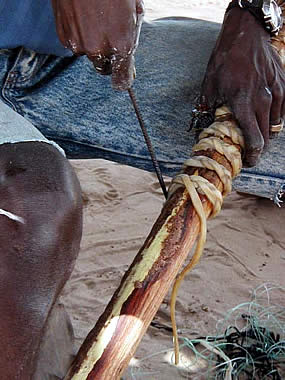 A sharp metal tool is used for this to plait the tuning rings tightly to the pole. After drying, this tuning ring fits snugly to the pole ready for the strings to be attached to it.
A sharp metal tool is used for this to plait the tuning rings tightly to the pole. After drying, this tuning ring fits snugly to the pole ready for the strings to be attached to it.
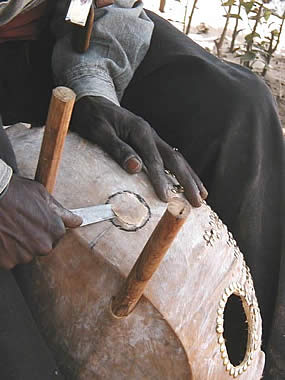 Holes must now be drawn and cut through the calabash to allow the neck pole to be fitted tightly through the calabash. A notched bridge stands upright on a wooden cushion on the skin (traditionally this is covered in red material). It has notches either side for the strings, ten on one side and eleven on the other. The strings are made from three different thickness of nylon fishing line. In former times they were made from cow skin, cut into thin strips and twisted, which gave a quieter sound. These were also much more likely to break.
Holes must now be drawn and cut through the calabash to allow the neck pole to be fitted tightly through the calabash. A notched bridge stands upright on a wooden cushion on the skin (traditionally this is covered in red material). It has notches either side for the strings, ten on one side and eleven on the other. The strings are made from three different thickness of nylon fishing line. In former times they were made from cow skin, cut into thin strips and twisted, which gave a quieter sound. These were also much more likely to break.
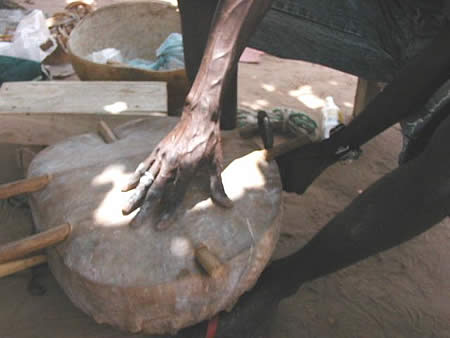 The 21 strings are attached either side of the bridge. One end of the string is looped several times round the tuning ring and the other end is knotted in the string holder. The string holders are made of either of a shoe-lace like material or double nylon lines and are attached to the iron ring that forms the tailpiece attached to the bottom of the pole. A hole is drilled through the bottom of the neckpole to take this iron ring
The 21 strings are attached either side of the bridge. One end of the string is looped several times round the tuning ring and the other end is knotted in the string holder. The string holders are made of either of a shoe-lace like material or double nylon lines and are attached to the iron ring that forms the tailpiece attached to the bottom of the pole. A hole is drilled through the bottom of the neckpole to take this iron ring
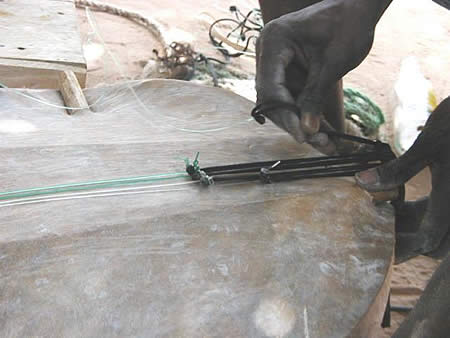 Tuning and scales. Tuning is achieved by pushing the rings up or down the neck. Then the loops of the string are pulled with a long iron nail to lengthen or shorten the strings to get lower or higher pitches. The rings hold their position well so tuning can be done in very fine microtonal intervals. Four named traditional heptatonic tunings are in general use. Siliba is the original kora tuning and the one in which the oldest kora songs are played. Tamora and Hardino are somewhat similar to a western major scale. For example, the seven-note scale of Tamora has three notes on standard pitch, two that are slightly flat and two that are somewhat sharp. In the Sauta tuning, the fourth degree of the scale is raised a half step. There is no real sense of absolute pitch in traditional kora music. The instruments are often tuned to match the range of the singer, though more often they will be tuned to a fixed pitch instrument that the player is going to play with, particularly the balafon.
Tuning and scales. Tuning is achieved by pushing the rings up or down the neck. Then the loops of the string are pulled with a long iron nail to lengthen or shorten the strings to get lower or higher pitches. The rings hold their position well so tuning can be done in very fine microtonal intervals. Four named traditional heptatonic tunings are in general use. Siliba is the original kora tuning and the one in which the oldest kora songs are played. Tamora and Hardino are somewhat similar to a western major scale. For example, the seven-note scale of Tamora has three notes on standard pitch, two that are slightly flat and two that are somewhat sharp. In the Sauta tuning, the fourth degree of the scale is raised a half step. There is no real sense of absolute pitch in traditional kora music. The instruments are often tuned to match the range of the singer, though more often they will be tuned to a fixed pitch instrument that the player is going to play with, particularly the balafon.

fROOTS ARTICLE
Vic Smith met Sherrifo in the spring of 2000 in The Gambia. He interviewed him and wrote this article which appeared, in a slightly abridged form, in fROOTS magazine :-
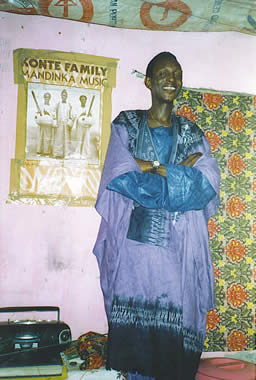 On the pink walls of his room, next to a poster of his father he has written the words, "Downfall of man is not the end of his life." There have been many times when he has needed to believe that message.
On the pink walls of his room, next to a poster of his father he has written the words, "Downfall of man is not the end of his life." There have been many times when he has needed to believe that message.
Sherrifo is the main breadwinner in his compound of twelve people. Then there are two half-brothers living in an uncle's compound - his mother remarried after Bai's death. He is trying to support them through high school. We met his mother, who is now blind, and he is trying to save for a cataract operation for her. Most unmarried musicians in their twenties, trying to build their careers, have only to think of themselves. In our long conversations, he sometimes seemed weighed down by all of the responsibilities he has taken on, but his sparky resilience, his enthusiasm, his natural joy meant that this soon passed and his jokey lively company was a great pleasure.
This range of emotion also came through in his kora playing and singing which at times can be dark and sombre, at others sparkling with delight and elation. He showed endless patience with our basic enquiries about the structure of his music and his instruments. He demonstrated that there are four different tunings of the kora, Silaba, Tomora, Hardino and Sowta, the last-named being the most compatible for playing with keyboards and other western instruments.
He carefully outlined the processes and stages of kora-making. Jalis are expected to construct their instruments and Sherrifo thinks he has made around ten so far. Each would take around two weeks to make. "You can only make it during the dry season because of the sun and the water. The box is a sawed calabash with sound holes cut into it. The neck and hand posts are a hard wood, usually mahogany and the skin is from a cow." Sherrifo's had two thicknesses of cow skin cut and attached at different places with a pattern in the attaching pins denoting the name or individual pattern of the maker or player. A strong metal ring makes the tailpiece and there is a ridged bridge for the 21 strings. Plaited cow skin attaches the strings to the neck and these are adjusted up and down for the tuning. At one time the strings would also have been made from very thinly cut cow skin but this has now been replaced by three different thicknesses of nylon fishing line. "My father was known as the best kora maker in The Gambia and I learned making as well as playing from him. Now there are many kora makers, making it as a business and selling it to the tourists, but if you want a kora that could be played professionally, you must go to a griot family."
He also took us to a number of places, travelling in "tanka-tankas", the overcrowded dilapidated minibuses and taxis that ply the roads between the main settlements, hooting for potential passengers. Surprise still registers on the face of the locals when they see "twobabs" travelling in this style.
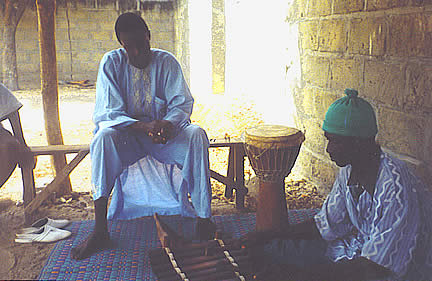 We visited the Swedish-sponsored music school near Serrekunda. It wasn't actually a good day to have called. Three people, including the local imam from that village, had died three days before in a horrendous car crash on their way to a naming ceremony and as a result many of the music pupils from these compounds were not at school. We did get the chance to meet and hear the superb balafon playing of Suntou Kuyatah, another Brikama man, who teaches the making and playing of balafon at the school. In the past Sherrifo had learned his balafon playing from Suntou as well as playing with him in the first band he had been in, the Babylon Band. Sherrifo also plays the djembe, keyboard and box guitar but the kora is his undying passion.
We visited the Swedish-sponsored music school near Serrekunda. It wasn't actually a good day to have called. Three people, including the local imam from that village, had died three days before in a horrendous car crash on their way to a naming ceremony and as a result many of the music pupils from these compounds were not at school. We did get the chance to meet and hear the superb balafon playing of Suntou Kuyatah, another Brikama man, who teaches the making and playing of balafon at the school. In the past Sherrifo had learned his balafon playing from Suntou as well as playing with him in the first band he had been in, the Babylon Band. Sherrifo also plays the djembe, keyboard and box guitar but the kora is his undying passion.
I thought it would give a perception into his music to ask him about other musicians, so I asked him to name his three favourite kora players and then the three greatest influences on West African music. He seemed to enjoy the question and smiled as he took his time to consider his answer carefully. The kora players were Toumani Diabete, Foday Musa Suso and his brother Dembo. The other three were Baaba Maal, Kasse Mady Diabate and Salif Keita.
The jali rightly showed great pride in his heritage. His great-grandfather was Jali Ndaba Konteh who played the 3-string konting and who brought his family to Brikama from the Kankaba region of Mali. His grandfather was Jali Ebrima Konteh. He became a kora player and taught his famous son Jali Alhaji Bai Konteh who in turn taught his four sons, Mamadou, Dembo, Bakiba and Sherrifo. The respect for the griot tradition extends beyond his own family. Walking with him through Brikama one day, we came on an old couple sitting outside their compound. He let it be known that he was very pleased to see them, spent time with them and introduced us to them. This was Amadou Samba, a narrator jali and his wife Yafatou who had been a noted singer in her day.
What did this articulate, polite, friendly, kind and hugely talented man want from life now? "I want to record. I feel ready. I want to develop my music. I would love to play in Europe. That is my aim and my passion; to follow my father and my brother." If this article can begin that process then it will have served its purpose.
Vic Smith
May 2001

BRITISH TOURS
Sherrifo made his first tour of England in September and October of 2004. It was a fairly hectic schedule with Sherrifo making 32 appearances in the 34 days he was in England The first photo shows him on stage at the Mumford Theatre in Cambridge, The second shows him in one of the junior schools where he was so warmly received. Here is the complete schedule of that tour:-
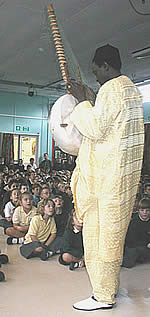 * 24/09 Flight from The Gambia
* 24/09 Flight from The Gambia
* 25/09 Healthy Concerts, Brighton
* 26/09 The Greys, Brighton
* 27/09 The Royal Oak, Lewes
* 29/09 Gattons School, Burgess Hill, W. Sussex
* 30/09 London Meeds School, Burgess Hill
* 02/10 Tenterden Folk Festival
* 03/10 Tenterden Folk Festival
* 04/10 BBC London recording for Radio 3 "World Routes"
* 05/10 Lindfield School, W.Sussex
* 06/10 The Orpheus Centre, Oxted, Surrey.
* 07/10 Harlands School, Haywards Heath
* 08/10 Mumford Theatre, Cambridge
* 09/10 Cranleigh Arts Centre, Surrey
* 10/10 Shenanigans, Bournemouth, Hampshire
* 12/10 Rocks Park School, Uckfield
* 14/10 Birchwood Grove School, Burgess Hill
* 15/10 Café Afrika, Cambridge
* 16/10 (Daytime) Apple Festival, Firle, East Sussex
* 17/10 (Evening) King's Church, Eastbourne, East Sussex - playing for a barn dance with The Sussex Pistols!
* 18/10 Farm Arts Centre, Chapel St. Leonards, Lincs
* 20/10 Sheddingdean School,Burgess Hill
* 21/10 Crowcombe and Stogumer Schools, West Somerset
* 22/10 Carhampton Hall, West Somerset
* 23/10 St. Peter's School, Guildford (with Musa M'Boob and Roger Watson)
* 24/10 Royal Oak, Lewes
* 25/10 Rocket FM Lewes (two hour live radio programme)
* 26/10 School Of African and Asian Studies, University of London
* 27/10 Recording tracks for a second CD at Country Branch Studios, Crawley.
On 29/10 Sherrifo flew back to The Gambia. To take a rest? No, on 1st November he started a new season of work at The Kombo Beach Hotel!
Sherrifo's second tour of England took place in the autumn of 2005. It was intended to make it a shorter, three week tour, but in the end it was extended to a very full five week tour.
 * Thu 6th October - School in Ashurst, West Sussex
* Thu 6th October - School in Ashurst, West Sussex
* Fri 7th October - School in Lewes, East Sussex
* Mon 10th October - School in Brighton.
* Tue 11th October - School in Firle, East Sussex
* Wed 12th October - School in Watchet, Somerset (Daytime)
* Wed 12th October - Bicknoller Village Hall, Somerset (Evening)
* Thu 13th October - School in Crowcombe, Somerset (am)
* Thu 13th October - School in Stogumber, Somerset (pm)
* Fri 14th October - School in Eastbourne, East Sussex
* Fri 14th October - Royal Oak, Lewes, East Sussex (eve)
* Sat 15th October - Brighton (Venue TBC)
* Sun 16th October - The Farm Venue, Chapel St. Leonards, Skegness, Lincs.
* Mon 17th October - School in Consett, Co. Durham (daytime)
* Mon 17th October - Barnard Castle Library, Co. Durham (evening)
* Tue 18th October - School in Newton Hall, Co. Durham (daytime)
* Tue 18th October - Newton Hall Library, Co. Durham (evening)
* Wed 19th October - School in Consett, Co. Durham (Daytime)
* Wed 19th October - Murton Library, Co. Durham (Evening)
* Thu 20th October - School in Crook, Co. Durham (Daytime)
* Thu 20th October - Crook Library, Co. Durham (Evening)
* Fri 21st October - School in Hunwick, Co. Durham (Daytime)
* Fri 21st October - Lanchester Library, Co. Durham (Evening)
* Sat 22nd October - Musicport Festival, Whitby, Yorkshire.
* Mon 24th October - St Paul's Cathedral, London (VIP reception after service to celebrate the 60th Anniversary of the United Nations)
* Tue 25th October - House Concert in Seaford, East Sussex
* Fri 28th October - House Concert in Lewes, East Sussex
* Sun 30th October - Rocket FM Radio, Lewes (2 hour live programme)
* Mon 31st October - School in Worthing, West Sussex
* Tue 1st November - School in Goring, West Sussex
* Wed 2nd November - School in Hassocks, West Sussex
* Thu 3rd November - School in Cuckfield, West Sussex
* Fri 4th November - promoting "The Gambia Experience" travel company, East Midlands Airport
Sherrifo undertook his third tour of England in September and October 2007:-
* Tuesday - 25th September - FLIGHT Banjul- Gatwick
* Wednesday - 26/09/2007 - Godstone - Orpheus Centre
* Thursday - 27/09/2007 - Day in School - Heyworth School, Haywards Heath W. Sussex
* Friday - 28/09/2007 Glasshouse Theatre, Stourbridge (afternoon performance for students - evening concert for public)
* Saturday - 29/09/2007 - House Concert, Warwick area
* Monday - 01/10/2007 - Day in School _ Estcots School East Grinstead, W. Sussex
* Tuesday - 02/10/2007 - Day in School Under One Sun - Crowcombe School, West Somerset
* Wednesday - 03/10/2007 - Knights Templar, Watchet, West Somerset
* Thursday - 04/10/2007 - Concert, Cube Theatre, Bristol
* Friday - 05/10/2007 - playing with The Sussex Pistols for a barn dance - Littlehampton
* Saturday - 06/10/2007 - Tenterden Festival, Kent
* Sunday - 07/10/2007 - Tenterden Festival
* Monday - 08/10/2007 -
* Tuesday - 09/10/2007 - Day in School, Park Mead Upper Dicker, East Sussex
* Wednesday - 10/10/2007
* Thursday - 11/10/2007 - Day in School, Pells School Lewes East Sussex
* Friday - 12/10/2007 - Day in School, Downs View School, Woodingdean
* Saturday - 13/10/2007 - playing with The Sussex Pistols for a barn dance - Tonbridge
* Sunday - 14/10/2007 -
* Monday - 15/10/2007 - Day in School, Hangleton Junior School, Hove
* Tuesday - 16/10/2007 - Day in School, St Martin's School, Brighton
* Wednesday - 17/10/200 - Day in School, West Hove School
* Thursday - 18/10/2007 - Concert, Square Chapel Halifax
* Friday - 19/10/2007 - Anglia Ruskin University (lunchtime concert and student workshops)
* Saturday - 20/10/2007 - playing with The Sussex Pistols for a barn dance - Surrey
* Sunday - 21/10/2007 -
* Monday - 22/10/2007 -
* Tuesday - 23/10/2007 -
* Wednesday - 24/10/2007 - Guildford Institute
* Thursday - 25/10/2007 - Royal Oak Lewes
* Friday - 26/10/2007 -
* Saturday - 27/10/2007 - Crawley Gambian Association
* Sunday - 28/10/2007 -
* Monday - 29/10.2007 -
* Tuesday - 30/10/07 - FLIGHT Gatwick - Banjul





